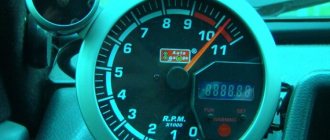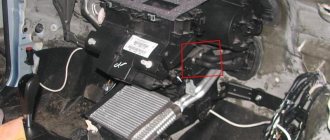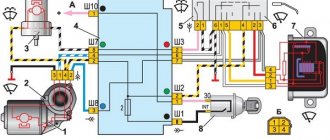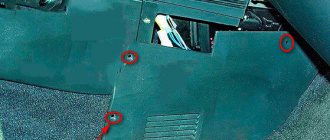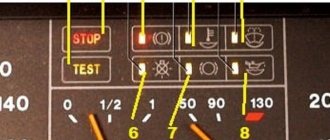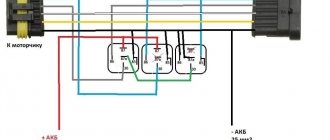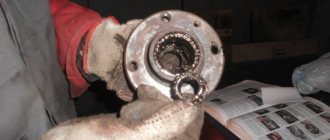The first car from the Zhiguli family equipped with a tachometer was the VAZ 2103. Neither 2101 nor 2102 had such a device. The tachometer is used to measure the crankshaft speed. It is a revolution counter, showing their number by deflecting the scale needle to a certain angle. The tachometer is also indispensable when setting up the carburetor - its indicators are taken into account when adjusting the idle speed and the quality of the fuel mixture.
VAZ-2106 tachometer connection diagram
The “Sixes” were equipped with a tachometer model TX-193. This tachometer consists of:
- plastic cylindrical body with glass holder;
- a scale divided into zones of safe and dangerous modes;
- backlight lamps;
- a milliammeter with an arrow attached to its shaft;
- electronic printed circuit board.
The principle of its operation is based on measuring the number of electric current pulses in the primary (low-voltage) circuit of the car’s ignition system. In the VAZ 2106 engine, for one revolution of the distributor shaft, corresponding to two rotations of the crankshaft, the contacts in the breaker close and open exactly four times. These pulses are removed by the device from the final terminal of the primary winding of the ignition coil. Passing through the parts of the electronic board, their shape is converted from sinusoidal to rectangular, having a constant amplitude. From the board, the current flows to the winding of the milliammeter, where, depending on the pulse repetition rate, it increases or decreases. The arrow of the device reacts precisely to these changes. The greater the current, the more the arrow deviates to the right and vice versa.
Connecting a tachometer in carburetor VAZ 2106
Electric circuit of the speed counter of the carburetor “six”
In a contactless ignition system, the tachometer is connected not to the coil, but to the switch
Connecting a tachometer in injection VAZs
It should be taken into account that the colors of the wires and their purpose may differ depending on the manufacturer of the device, but for the standard “TX-193” device, which is usually used in “sixes”, the diagram is as follows:
- First aid if the tachometer does not work on a VAZ 2107 with an injection and carburetor engine
- A white cable is required to connect the backlight.
- The red wire is connected to the ignition switch, a fuse is used for this, this cable supplies power when the ignition is activated.
- A white cable with a black break is required for connection to the car body.
- The brown wire connects to the K+ terminal on the coil.
- The black wire is connected to the charging current indicator relay. The latter, in turn, is installed on the right in the engine compartment.
- The gray-black cable is required to connect to the engine fluid pressure regulator installed to the left of the engine.
installation of a tachometer from a VAZ 2106 — Lada 2105, 1.5 l., 1998 on DRIVE2
Today I started installing the tachometer I bought.
I picked up 3 female terminals and 3 bolt terminals, and wire trimmings from work. The wires turned out to be all the same color - red, about half a meter each.
I started crimping the wires and, having clamped all the terminals, blunted them and did not measure them in length. It wasn’t enough (20 centimeters each), I found 1 wire (pink) in the car and extended it. I cut into 2 wires that go to the coil and insulated everything with heat shrink.
There is no need to drill any holes to route the wires into the interior. They just need to be inserted into the rubber seal for the wires and headlight hydraulic adjustment.
The tachometer has 3 contacts and 4 “holes” for light bulbs. 1 - instrument lighting and 3 - indicator lamps for oil, battery (charging) and handbrake. I have only connected the backlight for now. and later I’ll connect the oil and battery.
So here it is. you need to connect: “+12” to the “B+” terminal of the coil, “M” to the “K” terminal of the coil (there is also a wire from it to the distributor), and “|-“ (hammer) to any nearest ground.
I haven't thought about other devices yet. Most likely I'll keep the old big one. I'm thinking about a bracket in the suction area, but I'm still thinking about it and working on it.
Well, that's all. If you have any questions please contact)
UPD. For now I temporarily solved the device problem like this:
I didn’t attach it to the dashboard in any way. He sat down tightly and didn’t move. I saw a small problem. If you shake the impulse wire, the tach switches off, you will have to take it apart to see what’s wrong with it.
www.drive2.ru
Connection diagram for tachometer VAZ-2108 and 2109
Let us immediately note that the fuel supply system – injector or carburetor – does not play a special role here. As you know, currently the most common are cars with the following engine types: gasoline or diesel. Depending on this, the tachometer is selected, unless, of course, it comes in the stock version. The thing is that on gasoline engines the tachometer reads data from the ignition coil, or rather, the impulses that arise here. However, the design of diesel power plants does not provide for this unit. Accordingly, here the tachometer reads pulses not from the ignition coil (for lack of one), but from the generator.
The first two wires (12-volt and Signal) are to contacts “B” and “K” of the ignition coil, respectively. All that remains is to secure the mass in any convenient place.
Useful: VAZ starter connection diagram
Installing a tachometer on a VAZ 2105i — Lada 2105, 1.6 l., 2010 on DRIVE2
It was evening, there was nothing. After purchasing the tachometer, my hands were itching to connect it. Why would such a thing lie idle on a shelf?! In addition, there were some mythical doubts about whether it would fit or not. Where to begin. Naturally, you need to start by reading the manual. (in my case, from looking at the packaging =))
full set
And so we open the box, take out another box, take out the treasured bag, take out the piece of paper and what do we see? What we see is that we shouldn’t have skipped English lessons at school. Not just one Russian letter.
instructions
Filkina's diploma
But it is worth noting, however, the absence of Chinese characters, which in itself cannot but rejoice. In principle, if you really try to remember what you taught at school, you can intuitively guess that green is a signal from the ECU (ECU), black is for ECU ground, red is for + the ignition switch, and orange is the backlight. Everything is elementary simple. although there are a lot of things written there, all sorts of NOTE, Warning, DO NOT START ENGINE and other scary inscriptions in Latin letters, but the main thing is still 4 wires)) In the store they gave me a business card for the installation service, of course I could contact them, but there is a crisis outside and to I had no desire to go there. but then everything went like clockwork; we connect each wire; if with 3 everything is less clear, then with the fourth, namely the green one, you shouldn’t make a mistake. There is a red sticker on it, and lo and behold, it says in RUSSIAN not to connect to + do not connect to + coils, etc. open the VAZ 2107i diagram and see where the pulse signal to the tachometer comes from. There is a chip next to the ECU (3x3 round holes)
3x3
we find it and see that the “brown-red” wire comes in and doesn’t go anywhere. As a friend told me, feel free to connect such a wire throughout the domestic auto industry and you will be happy... And so it was done. After connecting, the question became where to put it; naturally, it should be placed in the instrument panel. Lo and behold, there are two quite important sensors, where should we put them? No where yet. After sitting and thinking about turning off the tachometer, I didn’t want to replace it, so I put it, like many others, in the middle of the dashboard. It doesn’t look important, I would say childish, but on the back it looks like a home clock. so I installed it as temporarily as possible until I find three sixth sensors and then I’ll stuff it into the dashboard...
temporary installation
teaser or first fitting))
www.drive2.ru
VAZ-2110 tachometer connection diagram
- tachometer VAZ;
- trip computer;
- ECM;
- crankshaft position sensor;
- ignition module.
Tachometer VAZ 2110 - with four outputs: if it is on a car with injection, it is connected not to the ignition (input 2), but to the ECM controller with an additional output provided for this (input 1) - and in this case it reads the number of revolution pulses directly from the controller. It receives a signal about the position of the shaft.
What to consider when installing
If you still decide to install the VAZ-2106 tachometer on the Oka, the diagram for connecting it to the ignition system will be the same. But the choice of installation location needs to be approached more thoroughly. You need to consider the following features:
- The tachometer installed on the panel should not block the view.
- It should not interfere with driving. This is especially true for cars like Oka.
- You definitely need to choose an option for decorating the device. He shouldn’t stand out, but it’s difficult to achieve this.
Sheet metal is perfect for making a housing for a tachometer. Some motorists use large coffee cans. But before you use it to make the body, you need to clean it to a shine, sand it, cover it with a layer of primer and paint it. This will increase the service life.
It is advisable to then cover the body with some material so that it harmonizes with the overall appearance of the interior - leatherette or dermantine is suitable. If you can find an attractive plastic case, that's great - it will look much better. And there is no need to prepare a place for installation - black plastic looks very good in the interior of an Oka or Kopeyka.
About the DPKV tachometer sensor
The tachometer has a sensor (crankshaft position sensor - DPKV). This device serves not only to count crankshaft revolutions, but also to determine its position at a certain moment, which is necessary for the electronic control unit to ensure proper operation of the power unit. When a metal object passes near the sensor core, an electrical impulse is generated in it, which is transmitted to the electronic engine control unit. The role of such an object in the power unit of a car is played by the crankshaft gear.
- To help the car enthusiast: tachometer connection diagram for VAZ 2109 carburetor
Types of tachometers
There are purely mechanical devices, as well as:
The first is a very old option. It makes no sense to use it due to imperfection and low accuracy.
For the “five”, the best choice would be an analog mechanical-electrical tachometer designed for the 2107 model. If you decide to change the entire panel, then we recommend staying with this option. For those who like the native shield, analogue remote instruments are available.
The electronic type does not have classic hands, but a display. All data is displayed in the form of numbers, which is very convenient. There is only one drawback to such products - the delivery of information with a slight delay.
The digital tachometer is the most modern. According to the principle of operation, it is similar to an electronic one, but has a number of additional functions (clock, calendar, etc.) and looks more attractive.
Why does the VAZ tachometer jump?
It often happens that the needle starts to twitch. If the car is fuel-injected, then troubleshooting involves connecting a diagnostic scanner and checking the engine systems. Jumps in the TX-193 needle in most cases are also a symptom of malfunctions associated with its electrical circuit. The reasons for this behavior of the device may be:
- lack of good contact at the negative terminal of the battery;
- oxidation or burning of the brown wire on the ignition coil;
- burning or wear of the contacts of the ignition distributor cap or slider;
- wear of the distributor shaft bearing;
- shorting the red wire powering the device to vehicle ground;
- malfunction of the crankshaft position sensor (for injection engines).
A similar problem is solved by stripping the contacts, replacing the ignition distributor cap, slider, support bearing, restoring the integrity of the insulation of the device’s supply wire, and replacing the crankshaft sensor.
Another jump may be due to the inoperability of the capacitor located at the bottom of the breaker. The capacitor may be broken or its contact is very weak.
If the tachometer on a VAZ does not work
Usually, the lack of response from the arrow is due to a broken contact in the connectors of the main wires of its connection, or damage to the wiring of the circuit. The first step is:
- Inspect the fastening of the conductor in brown insulation to terminal “K” on the ignition coil. If you detect poor contact, traces of oxidation, burning of a wire or terminal, fix the problem by cleaning the problem areas, treating them with anti-corrosion liquid, and tightening the fastening nut.
- Check the reliability of the connection of the black and white wire to the vehicle ground. If contact is broken, clean the wire and the surface to which it is attached.
- Using a tester, determine whether voltage is supplied to the red wire when the ignition is on. If there is no voltage, check the serviceability of fuse F-9, which is responsible for the integrity of the instrument panel circuit, as well as the condition of the ignition switch contacts.
- Disassemble the instrument panel and check the connections of the contacts in the tachometer wiring harness block. “Ring” all the wires going to the device with a tester.
The main function of a tachometer in a car is to determine the correct gear, which has a positive effect on the life of the engine. Most cars have an analog tachometer built into them during assembly. The driver looks at the arrow approaching the red line and knows when to shift into a higher gear. Not all cars have the type of device that satisfies the owner, so you just need to figure out what they have and how to connect the tachometer.
- Types of tachometers
- How to connect a tachometer via the ECU
- Connection diagram for a tachometer on a gasoline engine
- How to connect a tachometer to a diesel engine
- How to check the tachometer for functionality
Did you know? The term “tachometer” comes from the Greek
τάχος - speed and μέτρον - measure.
- Connection diagram for the VAZ-2106 tachometer on the VAZ-2101
Types of tachometers
There are two types of tachometers: digital and analog. The first looks like a small screen on which the driver can see all the data he needs while driving. The second one is simpler and looks like a board with arrows and values.
Remote
A remote tachometer is installed on the front panel of the car. For greater ease of placement, this device has a leg for mounting on the panel. Remote digital tachometers are good for monitoring idle speed. Their readings have fewer errors, so using such a device you can check the operation of a standard tachometer. In addition, their stylish appearance gives the car elegance.
Staff
The standard tachometer is built into the dashboard of the car. This device is more convenient, since it is easier for the driver to perceive the movement of one arrow, rather than several indicators while driving. A standard tachometer is more often used in cars, and manufacturers of electronic devices produce kits for self-equipping cars.
Important! Measuring instruments are produced according to the car brand. The readings from a non-native mechanism will be incorrect.
How to connect a tachometer via the ECU
If your car does not have a carburetor engine and the injector, the tachometer is not connected to the ignition. In this case, you need to connect the engine control unit to the controller. The connection diagram for the tachometer is simple: take the ground to the body (ground), connect the plus from the device to the ignition positive. The tachometer has two inputs: the first goes to the control unit, the second to the crankshaft position sensor. The device connected to the computer will read pulses directly from the control unit controller.
Connection diagram for a tachometer on a gasoline engine
Before installing a tachometer on a carburetor engine, read the instructions included with the device. If it is not there, install according to the following steps:
- Secure the mechanism in its place (the location is determined by the type of device).
- Connect the black wire to the ground (body) of the car.
- Connect the red wire to the ignition switch terminal, which supplies 12 W during operation of the ignition system.
- The third wire can be any color. Since the ignition system is contact and non-contact, we will consider where to connect the tachometer in both. With a contact system, the device is connected to the distributor breaker. In the second system - to the voltage switch.
If the car has a display backlight, the tachometer is connected to the terminal provided for this in the ignition switch.
We recommend: The process of replacing antifreeze in a VAZ-2110 car
How to connect a tachometer to a diesel engine
Before connecting, let’s figure out what makes the tachometer on a diesel engine work. The operating principle of an electronic device is to read pulses sent by a terminal located in the generator.
Since the process is labor-intensive, it must be carried out in an inspection pit.
The first point of work is to dismantle the protective casing of the generator, try to avoid getting dirt. The second step is connecting the tachometer to the diesel generator. To do this, find the terminal marked “W” on the generator body and connect the device output to it.
Attention! It is imperative to close the contact coming from the oil pump. If this is not done, the tachometer may “lie”.
It happens that the terminal indicated above cannot be found. In this case, disassemble the generator. Connect one of the wires connecting the winding and the rectifier to the tachometer cable. Insulate the wires and reassemble the generator in reverse order. Installing a measuring device is not very difficult, but without any knowledge of how a diesel engine works, how a tachometer works on a diesel engine, without the slightest idea about car repair, it is better to turn to professionals.
How to check the tachometer for functionality
We figured out how to connect a tachometer to a diesel and carburetor engine. Now let's look at the reasons for device breakdowns. You notice problems in the operation of the measuring device, for example, an arrow jumping in different directions. There may be several reasons for the breakdown. If the engine runs for a long time, vibration will occur, which may damage the display. The next reason may be oxidation of the contact group of the electrical wiring, damage to its insulation or disconnection from the tips. These are all visible causes that need to be eliminated immediately. If the sensor itself is broken, it needs replacement. If self-diagnosis does not reveal the cause, you should contact a car repair shop.
Interesting! The tachometer was designed by American Curtis Widder in 1903.
.
We recommend: Design and principle of operation of an automatic transmission
Subscribe to our feeds on social networks such as Facebook, Vkontakte, Instagram, Pinterest, Yandex Zen, Twitter and Telegram: all the most interesting automotive events collected in one place.
Part selection rules
An important device for cars
You can install this unit yourself. To do this you will need the following tools and materials:
First you need to find out the operating principle of the unit in question. The pulses read by this device enter the ignition system coil, displaying information on the screen. Auto mechanics recommend buying an electronic tachometer. When choosing this device, you should take into account the structural features of the VAZ 2105. Otherwise, the tachometer will show revolutions with a slight error. You can install a universal unit with switches. To do this, connect it to any type of engine.
In the selection process, you should also take into account the fact that there are dial and electronic tachometers. You can install a tachometer on a VAZ 2105 of the first type with a tuner. The second type includes the Balsat TX-319t model. It is a microprocessor device, the main task of which is to monitor the operation of the “five” engine. If necessary, the driver can select the most suitable mode. Before you figure out how to install a tachometer on a VAZ 2105, you need to take into account the capabilities of the car:
- measurement of crankshaft revolutions of 2-6 and 8-cylinder engines,
- availability of watches,
- ability to remember maximum and minimum temperatures,
- presence of a stopwatch,
- ability to measure crankshaft acceleration.
Installing an electronic tachometer involves independently adjusting the backlight. The advantages of the Balsat TX-319t among auto mechanics include the presence of a standby mode. This feature significantly reduces energy costs.
How to connect a tachometer of this type is of interest to many VAZ 2105 car owners. First, select a mounting location. The negative wire is then connected to the vehicle body. The plus wire is connected to the corresponding ignition terminal. A voltage of 12 W appears in it.
Connection to a gasoline engine
The connection of the device is different on an injection engine and with a carburetor. With the injector it is connected to the ECU controller. In this case, the “ground” is diverted to the body, and the positive wire must be connected to the positive ignition terminal.
The device has two outputs: one goes to the crankshaft position sensor, and the other goes to the ECU. Thus, it will read the number of revolutions from the controller of the control unit. Below is a diagram of connecting a tachometer with BSZ.
Scheme with contactless SZ
Below are instructions on how to connect an electronic tachometer to a gasoline power unit:
- First, depending on the type of device, you need to install it at the place where it will be located.
- Next, the installed tachometer should be connected. The negative wire is usually black and connected to ground.
- The red wire should be connected to the positive of the ignition switch, which is supplied with 12 V when the ignition system (SZ) is operating.
- The third wire can have any color - this is the input of the device. It is connected depending on the SZ. If the SZ is contact, then the device is connected to the distributor breaker; in the case of a non-contact SZ, it must be connected to a voltage switch.
- If the car is equipped with a backlight, the device must be connected to the car's size switch.
Scheme for contact SZ
Installed a tachometer on a VAZ 2105, + minor repairs. — Lada 2105, 1.6 l., 2008 on DRIVE2
Hi all! Finally, I got to the tachometer (: It came from China, I chose the diameter as the voltmeter, so as not to mess with anything, but simply replace the voltmeter with a tachometer. The on-board computer replaces the voltmeter, moreover, it even tells you if the voltage has dropped or risen above normal. Therefore, instead of a voltmeter, there will now be a tachometer. And with this installation, there is only one wire to pull, from the signal connector of the brain. The power is taken from the terminals that went to the voltmeter, the backlight power is from the backlight wire of the voltmeter. In general, nothing complicated.
Full size
This is how it will be now
Full size
it is in the dark time.
I connected the signal wire to the socket, there was just room for it. For those who don’t know where in the injection fives the output from the brain to the tachometer is, I’ll explain: if you remove the glove compartment, you see the brains behind it - you don’t need to touch them, you look a little to the left in the wires there’s a 9-pin connector hidden, of the 9 the least is used there of course, but of the wires present there, usually only one, brown with a red stripe, goes nowhere.
Full size
this is the connector
Full size
view from the glove compartment
It is the output from the brain to the tachometer. In general, I connected the wire from the tachometer there - everything works. There was no need to redo anything, everything was elementary. At the same time, I replaced the backlight bulbs with LED ones. I took better lamps, correspondingly more expensive, but it’s worth it, since the brightness adjustment works on them, and the cheap ones go out immediately. And the light is more pleasant, if necessary, you can make it brighter, the car has really been transformed. Here's what happened:
Full size
Full size
Full size
After installing the tachometer, I finally replaced the universal joint, this time the front one. Having removed the cardan, I noticed that the balancer had fallen off, but there was no vibration when driving after the replacement, although I haven’t checked it at speeds above 100 yet. At the same time I adjusted the wheel bearings.
This is where I ordered the tachometer: ru.aliexpress.com/item/2-…-shipping/1927695934.html
This is such an interesting pastime. Good luck to everyone on the roads!
www.drive2.ru
Ignition system for gasoline engines
Control of engine ignition processes can be organized by several methods:
- Distributor with one ignition coil;
- Distributorless with a dual (triple, quadruple depending on the number of cylinders divided by 2) ignition coil;
- Individual (for each spark plug).
In all cases, the coil receives a powerful pulse with an amplitude of 12V from a breaker (for cars before the 90s), a transistor switch, or directly from the engine control unit. It is from this point that the signal to the tachometer should be taken.
We recommend: Carburetor - do-it-yourself idle adjustment
Types of tachometers
The tachometer informs you about the number of crankshaft revolutions, which helps you determine at what point it is best to change gears. This makes it possible to increase the service life of the power unit and operate it competently, since the power and traction characteristics of the engine depend on the crankshaft speed. In addition, it can be used to accurately adjust the carburetor and other important idle speed components.
This meter can be analog, which is a display with arrows and numbers. When the needle approaches the red line, the driver must shift to a higher gear. On the digital device, information for the driver is displayed on a small screen (video author – Armadil).
Conventionally, devices can be divided into two types:
- Regular ones. They are installed at the factory that manufactures the vehicle. They place it on the torpedo.
- Remote. They are an alternative option if a factory device is not available. Remote devices have more accurate readings, so they can be used to check the accuracy of standard readings. Sometimes they are installed as tuning.
1. Standard device on the top five
2. Analog device for cars
3. Remote car devices
The tachometer can be installed on both a gasoline engine and a diesel unit.
Electronic tachometer and voltmeter VAZ 2105! — Lada 2105, 1.5 l., 1987 on DRIVE2
All owners of the VAZ 2105 car, popularly known affectionately as “Pyaterochka”, would like to change and improve a lot of things in their favorite car, so I decided to experiment a little and simplify my life! It all started because I got tired of guessing the engine speed by ear, and it was decided to install a tachometer. Well, as they say, google to the rescue, having looked through all the options, I didn’t find anything that I liked, after thinking a little about all the options, I decided to improvise. My heart was in favor of the electronic version, but I had no desire to install an external tachometer on the dashboard, I decided to go to auto stores, see what was on sale, I didn’t find anything useful, on my way back home I saw a store with various spare parts for do-it-yourself electronics, I decided to go in and have a look, and miracle, I found what I was looking for (below in the photo) I decided, I buy it, I came home happy, I looked at the purchase, everything is fine, simple, clear, just what I need... But damn, where should I put it now, I sat down and thought, nothing comes to mind, well, okay I put it aside and went to bed. In the morning I remembered that the voltmeter was acting up and then it dawned on me that I could add an electronic tachometer and an electronic voltmeter instead of the standard voltmeter, I quickly ran to the same store and bought an additional electronic voltmeter (second Photo), and voila The result of this miracle is obvious. Sorry for the quality, I filmed it on my phone))…
There is a corresponding entry about the backlight...
Issue price: 160 UAH
www.drive2.ru
Testing, tachometer adjustment
If the car is equipped with a distributorless or individual ignition system, the tachometer can be connected to any coil. In this case, the readings of the engine rotation speed (rpm) will be inadequate, since an impulse is supplied to the trammel ignition every stroke, while the individual ignition is four times less likely. However, it is possible to calibrate the measuring scale in a new way.
At the first stage of testing, start the engine and check the performance of the system (arrow deflection at idle speed). As a rule, the speed in this mode is in the range of 800 – 1000 rpm.
Next, adjust the reading level. If the tachometer needle deviates slightly, you can connect an additional capacitor with a capacity of about 1 μF between the signal wire and the vehicle ground. On the contrary, if the arrow goes off scale, connect a variable resistance of about 1 kOhm to the open signal circuit and scale the signal.
The next stage is sea trials. With the engine running, the maximum speed is reached. The tachometer needle should not go into the red zone. Otherwise, the adjustment is carried out again. Before starting operation, check the reliability of connections and insulation again. And remember, additional equipment means new problems.
A tachometer is a very useful device. It is not surprising that many owners of carburetor VAZ-2105 are thinking about installing it on their cars, because the manufacturer did not take care of this at one time. It is not difficult to connect the device yourself. We will tell you in more detail how to do this in the article below.
Tachometer speed does not work - why does the needle “jump”
Here are some tips from experienced car owners:
- look for the Check indicator (if there is no signal, self-diagnosis will not help);
- check connections and voltage with a tester;
- in case of parallel incorrect operation of other devices, test the “ground”;
- inspect the distributor parts;
- check the condition of the circuits;
- If problems occur at high engine speeds, diagnose the switch.
If, as a result of repair work, the tachometer does not work well, adjustment is required (adjusting the “0” position and the unit, checking the quality of connections).
The tachometer on the instrument panel does not work? Replace it. In theory, this is not difficult, but it is better to find detailed video instructions in advance (select the option specifically for your engine - diesel or gasoline).
Before purchasing a unit, be sure to check its compatibility with the machine.
Why install a tachometer
The main purpose of the device in question is to record the number of revolutions made by the operating crankshaft. Experienced drivers do not particularly need this control device, and therefore they do not experience discomfort from the fact that their VAZ-2105 does not have it.
It is difficult for novice car enthusiasts to drive without a tachometer, because it is not always possible to monitor the operation of the engine only by sound. It is often inaudible on a noisy street or when the radio is on in the cab.
Meanwhile, the device not only allows you to control the crankshaft rotation speed, but it also helps:
- determine the optimal moment to change gear;
- adjust the idle speed of the car;
- identify floating speeds;
- find out the torque;
- identify some engine malfunctions at an early stage.
What is a tachometer for?
The tachometer is designed to measure the crankshaft speed. In essence, it acts as a kind of rotation counter, indicating their number to the car owner by moving the scale cursor to a specific angle. With its help, the driver, while behind the wheel, can observe the order in which the VAZ-2106 power unit functions. In addition, he sees whether there is excess load on the car or not. Based on the received data, it is easier for the driver to select the desired speed. Meanwhile, the tachometer is useful when adjusting the carburetor. Its parameters are taken into account when adjusting the idle speed, as well as the quality of the fuel.
Varieties
Tachometers produced on the market differ from each other in design and method:
- installations and connections;
- operating principle.
Also, special devices are produced for injection and carburetor engines - they are not interchangeable. For the VAZ-2105, a remote device is usually selected, since there is no room for a standard one in the panel of this car.
There are also non-contact varieties of tachometers. They don't need any connection at all. You just need to understand that these devices are used rather as diagnostic equipment that helps check the engine and adjust it. That is, they are not used in the mode of permanent recording of readings.
For those wishing to install a standard device, we recommend that you first replace the original dashboard with the one designed for the VAZ-2107 model. This shield has a socket, which means installing a tachometer on the 2105 will not cause any difficulties.
The remote type is placed in any convenient place - it comes with a special support leg. Instead, it is permissible to use double-sided tape. The cheapest option is the standard ones.
What does a tachometer do?
Its work is based on reading crankshaft revolutions. This is necessary in many life situations. Experienced car owners may argue that it is of no use on the VAZ 2105. This is fundamentally wrong. It’s enough to imagine a situation where you can’t hear the engine running due to noise on the street or loud music in the cabin. You can drive based on the speedometer, but what if the car, for example, is heavily overloaded or has a trailer?
To put it briefly, you can make a list of tachometer functions.
- Determining the optimal moment for changing gears.
- Detection of floating revolutions.
- Determination of surges and maximum torque.
- Idle speed adjustment.
- Helping beginners learn how to drive a car.
- Ease of use in noisy environments.
- Early detection of engine or electrical problems.
- Reduces engine wear and saves fuel thanks to timely gear changes.
There are many types of tachometers. What are the differences between them?
- Installation.
- Tachometer type.
- Differences between carburetor and injection systems.
- Connection method.
- Principle of operation.
Installation
There are 3 main options for this parameter:
Installation of standard devices is carried out in the panel. We are talking about a shield with a VAZ 2107. Remote ones can be located anywhere. They come with a special leg for fastening. You can use either adhesive tape or double-sided tape. In a word, everything depends on the flight of fancy. Non-contact tachometers do not require connection, which means that installation is not necessary for them. It should be taken into account that such devices are not designed for constant monitoring of speed. They are better suited for checking, tuning the engine and the main tachometer.
The cost of standard devices is the lowest, remote devices are slightly more expensive, and non-contact devices are several times superior to previous types.
By type, all tachometers are divided into:
A mechanical tachometer is a rarity. These are the very first devices that were installed on cars. Its use today has no basis other than adherence to retro style. Analog tachometers are the main type that is found on the VAZ 2105. They have the form of a dial and a arrow, less often, a vertical or horizontal scale. These are the devices installed in panel 2107, but they can also be remote.
The electronic type is housed in a plastic box and has a display. The revolutions are indicated here in digital form. Sometimes such devices have a slight delay in readings, but their accuracy is higher than analogue ones.
And the last type is the most modern. This is a digital tachometer. It has a lot in common with the electronic one, but the display is better. Capable of displaying several different dimensions at the same time and having a nice design. This is the most expensive type.
Injector and carburetor
Many car owners have long switched to using an injector instead of a carburetor. The tachometer of the injector and carburetor has a slight difference. But it will not work correctly, without intervention in the design. You need to pay attention to this.
Connection method
The device is selected for a specific type of engine. The connection is carried out strictly according to the tachometer instructions. The colors and purpose of the wires may vary greatly.
The most common connection is 3 wires:
This connection is used when replacing the tachometer on a panel from a VAZ 2107.
The second connection is more often used on remote devices. It looks like this:
- “+” to “+”, to the terminal marked “B+”;
- “–” to “–” or “ground”;
- “signal” to the coil (contact “K”).
There are all sorts of options that allow you to use the device for your own purposes. For example, the connection determines when and how the device will turn on. The choice depends on the owner’s knowledge of the car’s electrical circuits and the flight of his imagination.
Installation Features
As noted above, owners of the VAZ-2105 are recommended to replace the instrument panel with the one that was mounted on the 2107. If you do not want to do this, then a remote option is selected. It is fixed either on the bracket supplied in the kit or in a special frame-pocket - those are sold separately.
For the 2105 model, the tachometer designed for the VAZ-2106 is perfect. To connect it, you will have to cut off the connector with contacts, since there is nowhere to plug it into the “five”. Further switching is done by extending the wires and connecting them with terminal strips (sold in electrical goods stores).
It is important to consider the following:
- one cable (marked with brown insulation) is attached to the plus of the ignition coil;
- black and white goes to mass;
- orange (sometimes yellow) connects to battery positive.
The electronic tachometer is installed in the same way.
VAZ 2105 “INSTALLING A TACHOMETER” (injector)
Possible duplicates found
Tachometer, okay, to taste and color. Injector 5 - where did you get it? And what volume?
I think the Lada 2111 is full of this bullshit and this has no place
show me exactly this explanation) otherwise I was trying to figure out how to do it, even the Lada didn’t help.
find the block, connect the wire, and for this you need a whole video guide? Or is there not enough imagination on where to install the device? and you definitely need help with different installation options in pictures. rave.
Installation on a car with a carburetor
Before connecting the tachometer, it must be installed in the location chosen for it. This way you can immediately see how long of wire you will need. Then the negative cable is connected to ground. It is, as previously reported, black and white or completely charcoal.
Connect the brown or red wire to the ignition switch contact. Look at the diagram where the positive from the battery comes. If it is not there, then find it using a tester. This is done like this:
- set the multimeter to 20 V;
- Place the black probe on ground;
- Touch all the contacts in red one by one - the one you are looking for will have 12 volts.
The last posting is used to obtain data on the number of crankshaft revolutions 2105. Its color is not defined, each manufacturer uses its own. This cable in the contact ignition system goes to the distributor breaker. Otherwise, it is connected directly to the voltage switch. If the tachometer has its own backlight, then it is additionally connected to the car’s side lights circuit.
Installation of the HELIOS 500 tachometer on a VAZ 2105 — Lada 2105, 1.5 l., 1998 on DRIVE2
Good day to all! I thought for a very long time and wondered what kind of tachometer to install, I didn’t really want to farm something and spoil the torpedo, installing a tachometer 06 and again collectively farming the remaining sensors was a chore... Although on the one hand, all sorts of tuned tachometers seem to look good. But the choice fell in favor of simplicity, cost and so as not to spoil anything))))) I took the HELIOS 500 tachometer
The tachometer has 5 modes: revolutions, hours, ignition angle, voltage and some other crap, it seems to show the operating time of the car from the moment the ignition is turned on until the moment it is turned off. Two points were important for me, first of all, the speed, and the presence of voltage, I was also pleased! The basis is always the speed, sometimes I look at the voltage, I don’t use the rest at all! Since I connected it to the ignition switch and therefore it only works after turning the key, therefore the clock always gets lost! And God bless them, we're pulling the wiring
Two points were important for me, first of all, the speed, and the presence of voltage, I was also pleased! The basis is always the speed, sometimes I look at the voltage, I don’t use the rest at all! Since I connected it to the ignition switch and therefore it only works after turning the key, therefore the clock always gets lost! And God bless them, we're pulling the wiring
I made a hole on the side for the wiring and installed it on 2-sided 3M tape! views from all sides:
And also a couple of videos of his work!
Part 1 operating modes
Part 2 tachometer response to the gas pedal “revolutions”
Part 3 backlight modes
Oh yes, if anyone needs a connection diagram, here it is:
Honestly, for me this is the best option for a tachometer that can be installed on a five-wheel torpedo, in terms of cost, work, simplicity and, of course, beauty!
He fits in perfectly, nothing is messed up, nothing gets in the way! I was very happy! I recommend! Thanks to all)
www.drive2.ru

